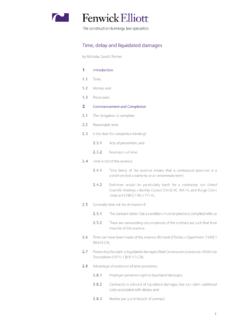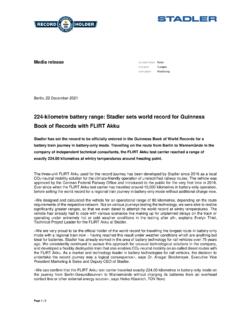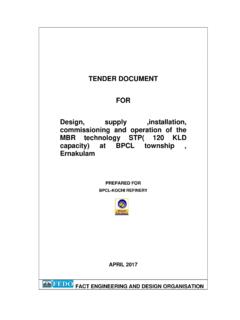Transcription of Sustainable Development in the Construction Industry
1 Sustainable Development in the Construction IndustrySustainable provisions in Construction contractsIntroductionDuring today s seminar, you will have heard wide-ranging discussions about 1. what sustainability means and how sustainability and environmental concepts are being adopted within the Construction Industry . The purpose of this paper is not to enter into that debate but rather to consider whether it is possible to adopt those concepts within a contractual framework. Of course it is worth repeating at the outset the well-known defi nition of sustainability provided by the Brundtland Report: Sustainable Development is Development that meets the needs of the present without compromising the ability of future generations to meet their own needs.
2 So how can that be refl ected within Construction contracts? Every project 2. needs a clear set of contractual requirements and obligations so that all the participants know where they stand. Remember that a contract should set out:what each party must do;(i) what each party receives;(ii) the time for performance;(iii) (sometimes) consequences of failure; and fundamentally(iv) where risk is to fall. (v) Remember too that there are three basic stages to any Construction 3. project:design;(i) build; and(ii) operation.(iii) Construction projects and contracts are of course already subject to 4. certain sustainability provisions. The Government has introduced a number of legislative provisions, (some of which are mandatory some of which are voluntary) which fall within the sustainability umbrella.
3 This will continue as the Government is committed to improving resource effi ciency and sustainability as part of its drive to address climate change. These provisions include:the Site Waste Management Plans Regulations 2008, SI 2008/0314;(i) Building Regulations which were most recently amended on 9 (ii) September 2008 through Gloverpage 2 Sustainable Development in the Construction IndustryEnergy Performance of Buildings (Certifi cates and Inspections) (England and Wales) (Amendment ) Regulations 2008, SI 2008/2363; Housing and Regeneration Act 2008 section 317: Time Limit for Prosecutions of Breaches of Building Regulations and the Housing and Regeneration Act 2008 (Commencement No. 1 and Transitional Provision) Order 2008; and The Building (Electronic Communications) Order 2008 (SI 2008/2334); Landfi ll Tax introduced in Finance Act 1996, Aggregates Levy (iii) introduced in Finance Act 2001, Climate Change Levy introduced in Finance Act 2000; andCode for Sustainable Homes 2008 (Department for Communities and (iv) Local Governments) - take the fi rst of these the Site Waste Management Plans Regulations 5.
4 The Government decided that something needed to be done, after an Environment Agency study1 identifi ed that: over 50% of all landfi ll in the UK could comprise Construction waste;(i) 10 million tonnes of new Construction products are wasted every (ii) year, at a cost of over billion; and thereforea 1% reduction could mean annual savings of 15 million.(iii) Accordingly, the Government has set a target to reduce waste disposed of 6. to landfi ll from Construction -related activities by 50% by The Regulations aim to reduce the amount of waste and encourage the use of recycling. Any Construction project with an estimated cost exceeding 300,000 must have a Site Waste Management Plan ( SWMP ) in place before the Construction works begin.
5 The SWMP, which must be updated every six months,3 must set out the amount and type of waste that it is estimated will be, and is in fact, produced on a Construction site and how it will be reused, recycled or otherwise disposed of. There are more onerous obligations on projects with a value of more than 500, drafting a Construction contract, careful steps must be taken to set out 7. who is responsible for complying with these regulations. Once Construction work has commenced, it is the principal contractor s responsibility to update the plan and to ensure that all other contractors and workers on-site are aware of it and its location. However, the principal contractor does not necessarily mean the main contractor. It simply means the contractor identifi ed as such in the plan.
6 This means that those drafting tenders and Construction contracts must 8. take the following into account:The need to identify the client and principal contractor and the need (i) for the contract to contain a declaration that the client and the principal contractor will take all reasonable steps to comply with the duty of care regime in the Environmental Protection Act 1990 and the Environmental Protection (Duty of Care) Regulations 1991 and that waste will be managed appropriately;The need to identify who is responsible for drafting and updating the (ii) SWMP;1. The Economic and Environmental Benefi ts of Re-source Effi ciency in Construction , March 20082. The increase in the standard rate of landfi ll tax on waste disposed to landfi ll to 32 per tonne in 2008/09 and the planned yearly increases of 8 per tonne until at least 2010/11 are part of this During the Construction works, the SWMP must be kept at the site offi ce or at site.
7 It must then be retained by the principal contractor for two years after the completion. 3 Sustainable Development in the Construction estimated project value;(iii) What decisions have been made in relation to the nature of the (iv) project, its design, Construction method or the materials to be used in order to reduce waste and/or recycle materials? Should targets be set? In other words, perhaps, what thought has been given to sustainability provisions?Identify the different types of waste that will be produced in the (v) course of the project, estimate the quantities of each different waste to be produced, and describe what waste management action will be taken; andWho is to be responsible for removing the waste? Who is to be (vi) responsible for the costs of removing the waste?
8 Who takes the risk for delays caused by the removal of waste or the need to recycle materials?There are inevitably penalties for non-compliance. The consequences of 9. the failure to keep and/or update a SWMP include: fi xed penalty notices, or on conviction in the Magistrates Court a fi ne of up to 50,000. (On conviction in the Crown Court an unlimited fi ne can be imposed.) Potentially, as the breach of the Regulations is an environmental offence, directors and offi cers of the companies concerned may face individual liability. Of course, most contracts contain fall-back provisions that parties must 10. comply with local laws. Clause of the FIDIC Red Book notes that:(i) The Contractor shall, in performing the Contract, comply with applicable Laws.
9 Clause of the JCT Standard Form of Building Contract notes that:(ii) The Contractor shall carry out and complete the Works in a proper and workmanlike manner and in compliance with the Contract Documents, the Health and Safety Plan and the Statutory Requirements. These clauses are saying that a contractor must comply with all applicable 11. environmental laws and regulations in force at the time, in relation to the particular contract. Therefore to take the example of the Site Waste Management Plan Regulations, you could simply add a reference to the SWMP, in clause of the JCT Form. The design and tender stageEqually, of course, the need to consider the requirements of the Site Waste 12. Management Plans Regulations needs to be taken into account quite carefully during the planning and tender stage of the project.
10 And it is here that sustainability provisions will come to the fore. Yes, every project must comply with the applicable local legislation, but just how far do you want to go?Of course, there is no reason why the tender itself should not be part of 13. the drive to sustainability. Why not consider e-tendering - an electronic tendering solution that facilitates the complete tendering process from the advertising of the requirement through to the placing of the contract. This includes the exchange of all relevant documents in electronic format. Some of the potential benefi ts4 certainly have a Sustainable feel:page 4 Sustainable Development in the Construction tender cycle-time;(i) Fast and accurate pre-qualifi cation and evaluation, which enables the (ii) automatic rejection of suppliers that fail to meet the tender specifi cation;Faster response to questions and points of clarifi cation during the (iii) tender period;Reduction in the labour-intensive tasks of receipt, recording and (iv) distribution of tender submissions;Reduction of the paper trail on tendering exercises, reducing costs to (v) both councils and suppliers;Improved audit trail increasing integrity and transparency of the (vi) tendering process.














